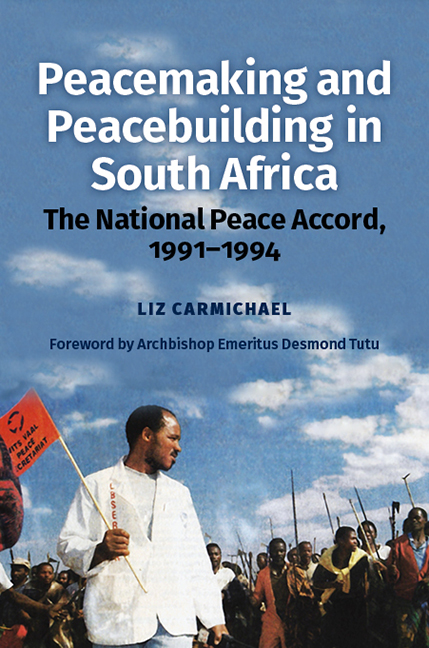Book contents
- Frontmatter
- Dedication
- Contents
- List of Illustrations
- List of Abbreviations
- Glossary
- Acknowledgements
- Note on Nomenclature
- Transition Timeline
- Foreword
- Introduction
- Part One Peacemaking, Peacebuilding, and the South African Conflict
- Part Two Peacemaking
- Part Three Peacebuilding
- Conclusion: Impact and Unfinished Business
- Bibliography
- Index
16 - Building Peace in the Regions I: Natal/KwaZulu, Wits/Vaal
Published online by Cambridge University Press: 08 October 2022
- Frontmatter
- Dedication
- Contents
- List of Illustrations
- List of Abbreviations
- Glossary
- Acknowledgements
- Note on Nomenclature
- Transition Timeline
- Foreword
- Introduction
- Part One Peacemaking, Peacebuilding, and the South African Conflict
- Part Two Peacemaking
- Part Three Peacebuilding
- Conclusion: Impact and Unfinished Business
- Bibliography
- Index
Summary
Introduction
Each regional peace committee was entrusted with making and building peace in their region, establishing and supporting as many local committees as necessary. When staff were appointed, starting late in 1992, the structures acquired Regional Directors, coordinators, fieldworkers, and secretaries, to support the LPCs and promote the whole range of peace activities. Every region faced the historic divides between races, and between the government and people. This chapter offers a flavour of the two regions which in addition were called to make peace in the ANC–IFP conflict.
Natal/KwaZulu (from 1994 KwaZulu-Natal, KZN)
This, the most violent region, struggled the most. Political disagreements inhibited the appointment of staff, making it the least well resourced. The violence was complex and intractable, a patchwork of tiny wars affecting particularly the Midlands, the North, the South Coast, and Durban townships.
The ANC's Bheki Cele, then an ANC MK activist just returned from Robben Island, Chair of Durban South ANC, says simply: ‘KZN was a hell on earth, no doubt about it. The trouble started much earlier and ended much later in this province. … But I’d be lying if I said the Peace Accord as a structure didn't make an impact: it was positive.’ He and others describe it as the unique place of meeting with the enemy, and even making friends. Unlike Wits/Vaal the structures in Natal/KwaZulu cannot be described as an efficient, fast-moving mechanism. It was much more about personalities and relationships.
While the NPA was being negotiated there was a chorus of unease, from Buthelezi and non-aligned observers alike, at the lack of consultation at regional and local level. ‘In this region’, wrote Peter Gastrow (DP MP for Durban Central), ‘extensive grassroots involvement will be necessary in establishing the regional and local structures if they are to survive and be effective. I therefore plead for a “bottom up” approach to be followed.’ Steve Collins of IDASA in Durban similarly remarked that the negotiation process, ‘while being inclusive at a national level has not been discussed in principle or in detail in the region most affected by the violence’.
- Type
- Chapter
- Information
- Peacemaking and Peacebuilding in South AfricaThe National Peace Accord, 1991-1994, pp. 352 - 378Publisher: Boydell & BrewerPrint publication year: 2022

